Abstract
The effects, over periods from 3 days to 9 months of administration, of diets containing di-2-ethylhexyl phthalate are very similar to those observed in rats administered diets containing hypolipidemic drugs such as clofibrate. Changes occur in a characteristic order commencing with alterations in the distribution of lipid within the liver, quickly followed by proliferation of hepatic peroxisomes and induction of the specialized P-450 isoenzyme(s) catalyzing omega oxidation of fatty acids. There follows a phase of mild liver damage indicated by induction of glucose-6-phosphatase activity and a loss of glycogen, eventually leading to the formation of enlarged lysosomes through autophagy and the accumulation of lipofuscin. Associated changes are found in the kidney and thyroid. The renal changes are limited to the proximal convoluted tubules and are generally similar to changes found in the liver. The effects on the thyroid are more marked. Although the levels of thyroxine in plasma fail to about half normal values, serum triiodothyronine remains close to normal values while the appearance of the thyroid varies, very marked hyperactivity being noted 7 days after commencement of treatment, this is less marked at 14 days, but even after 9 months treatment there is clear cut evidence for hyperactivity with colloid changes which indicate this has persisted for some time. Straight chain analogs of di-2-ethylhexyl phthalate, di-n-hexyl phthalate and di-n-oxtyl phthalate differ entirely in their short-term effects on the liver and kidney but have similar effects on the thyroid. The short-term in vivo hepatic effects of the three phthalate esters can be reproduced in hepatocytes in tissue culture. All three phthalate esters, as well as clofibrate, have early marked effects on the metabolism of fatty acids in isolated hepatocytes. The nature of these changes is such as to increase storage of lipid in the liver. A hypothesis is presented to explain the progress from these initial metabolic effects to the final formation of liver tumors.
Full text
PDF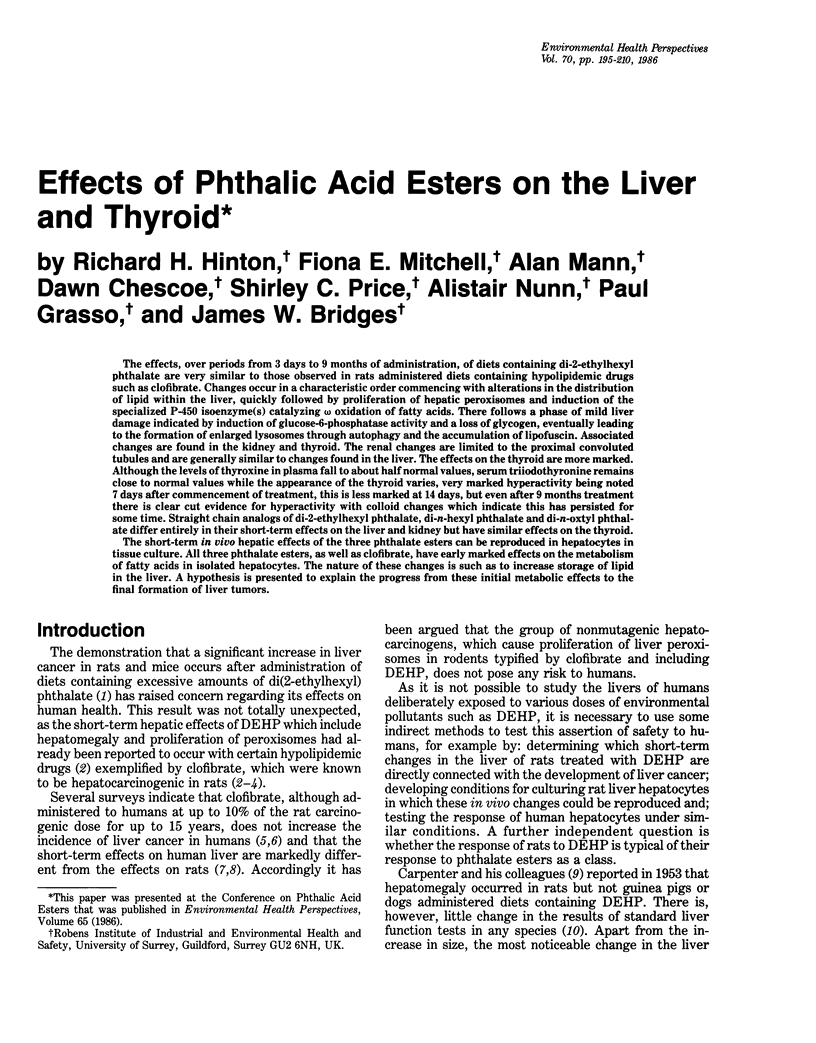
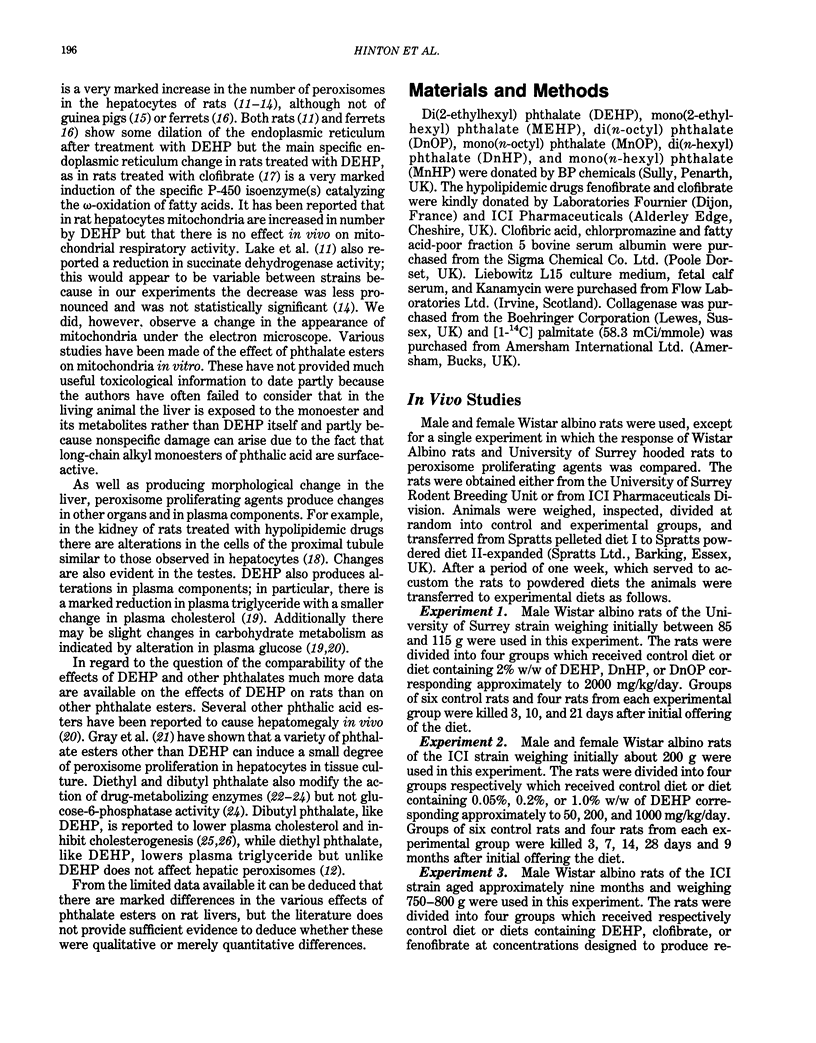
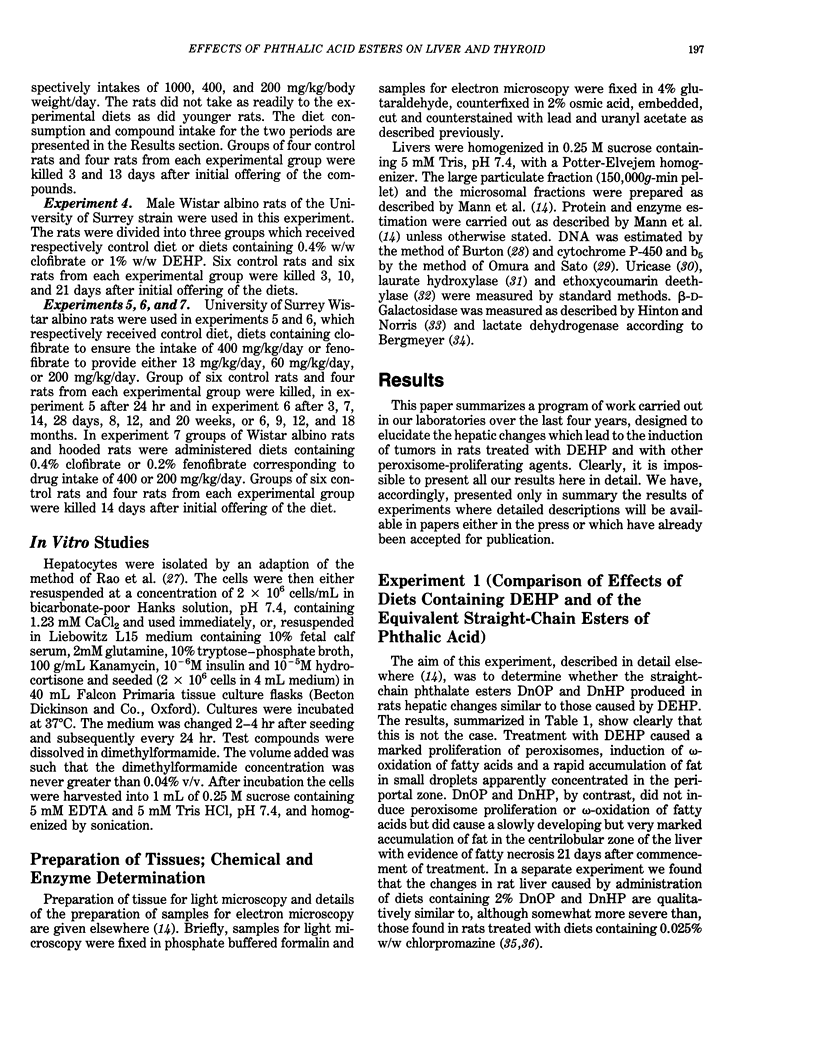
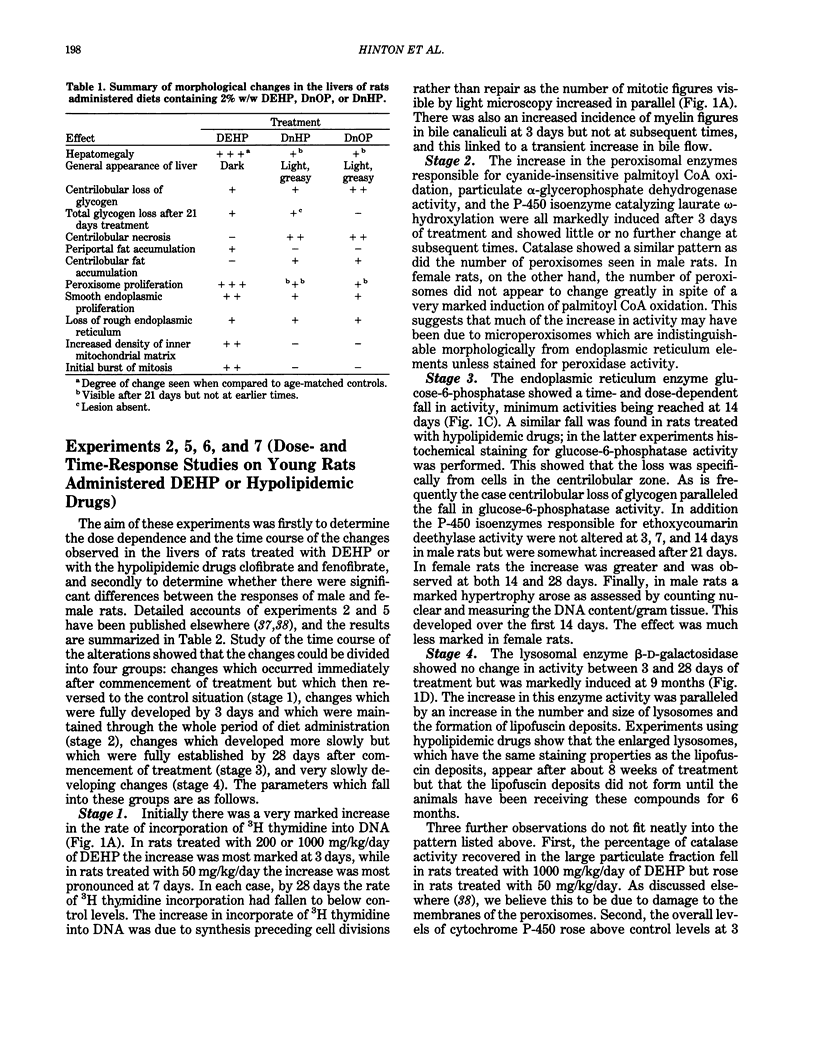
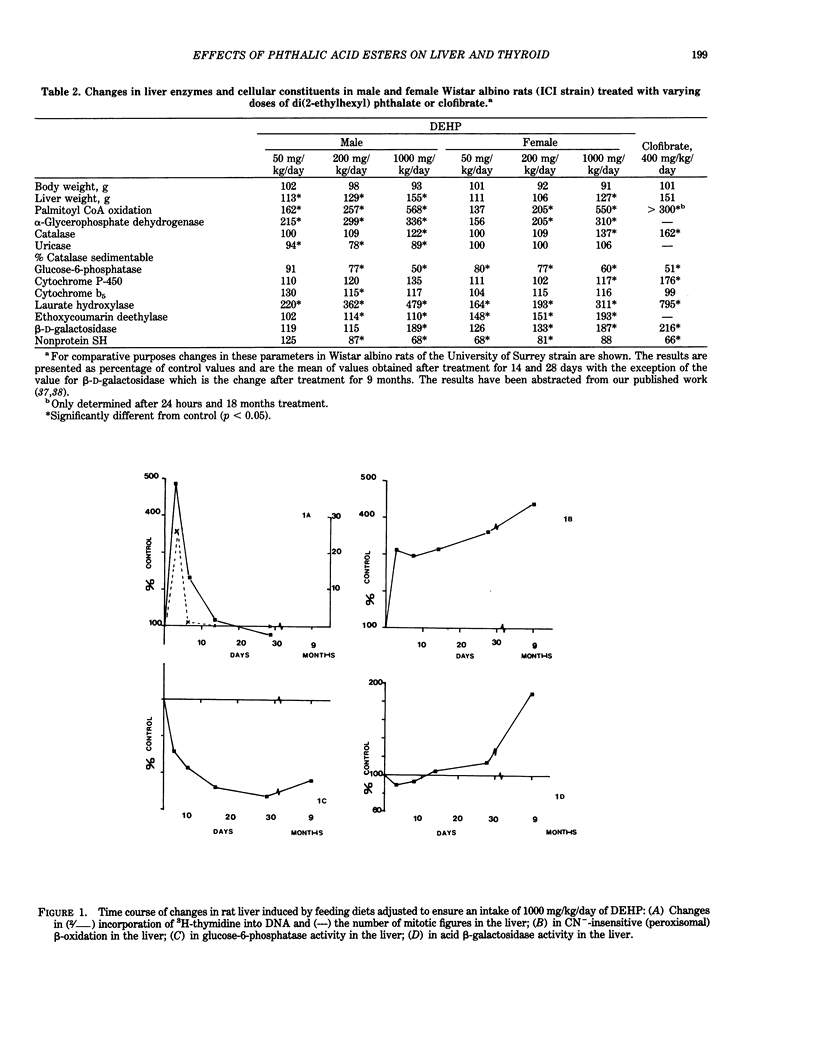
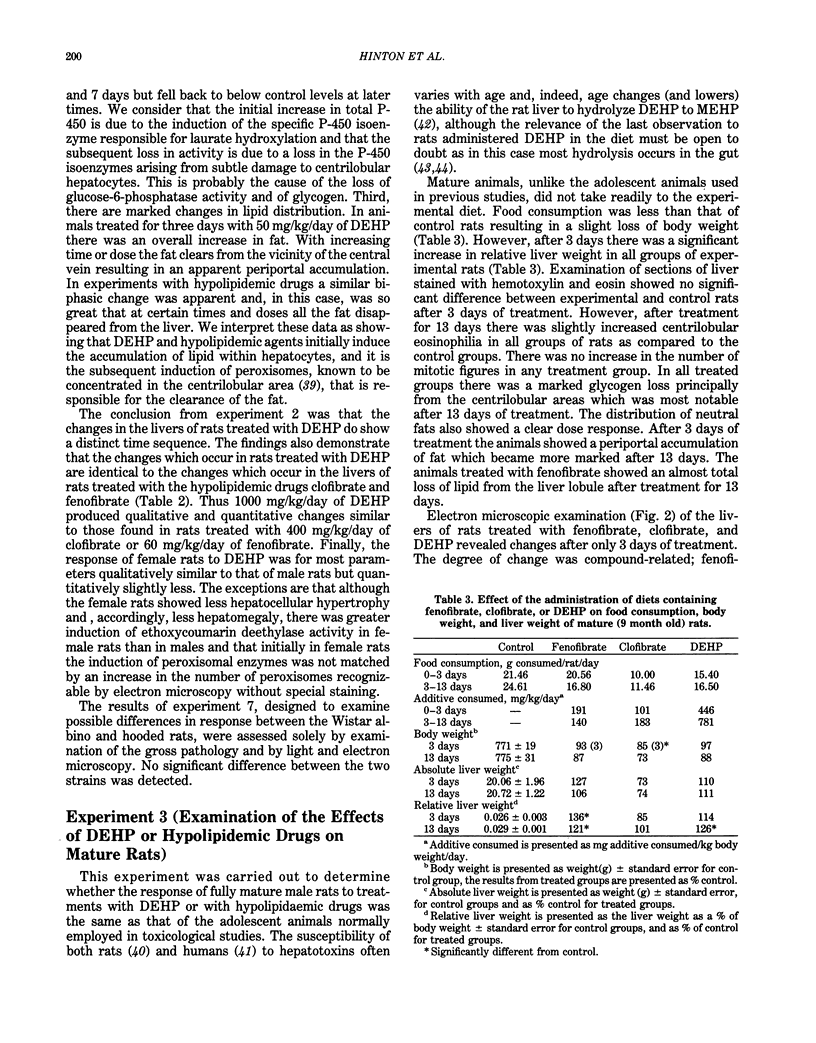
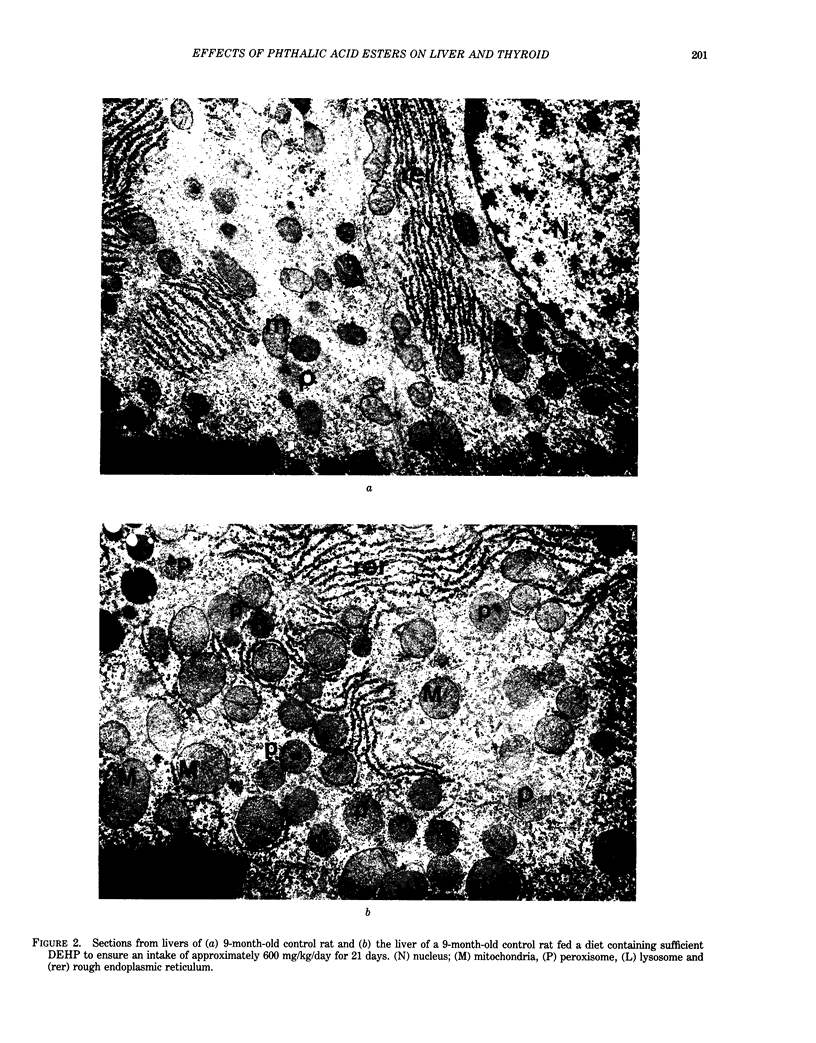
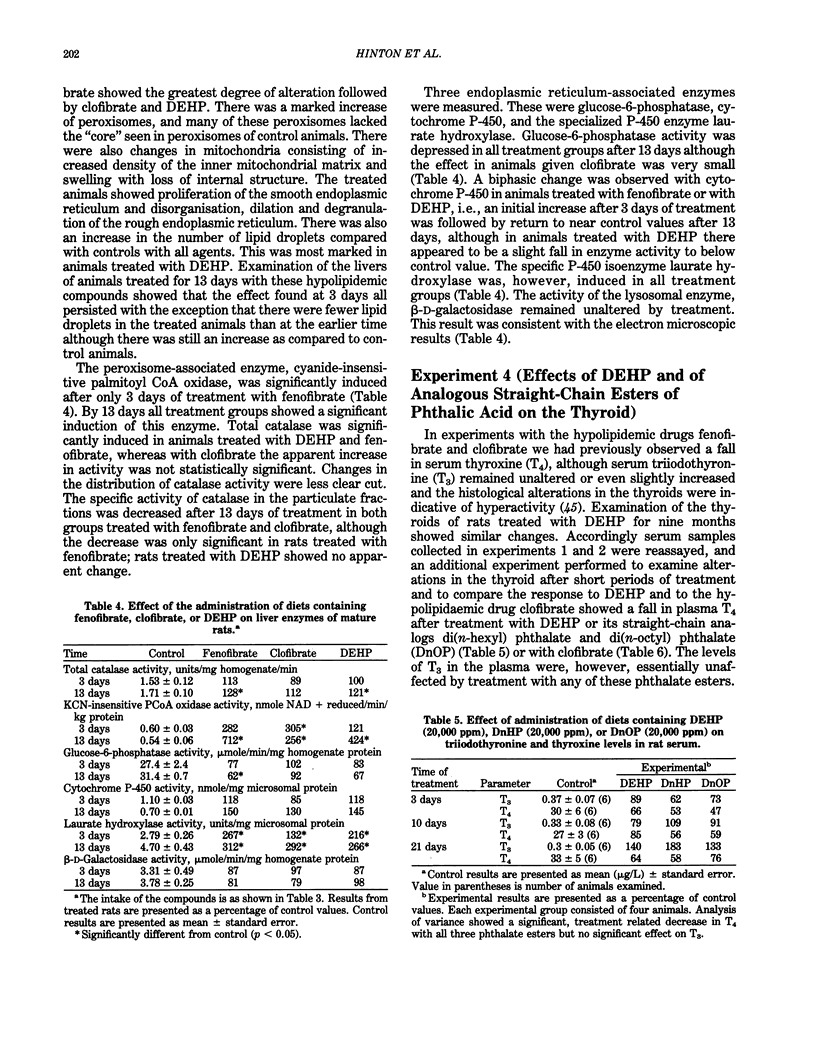
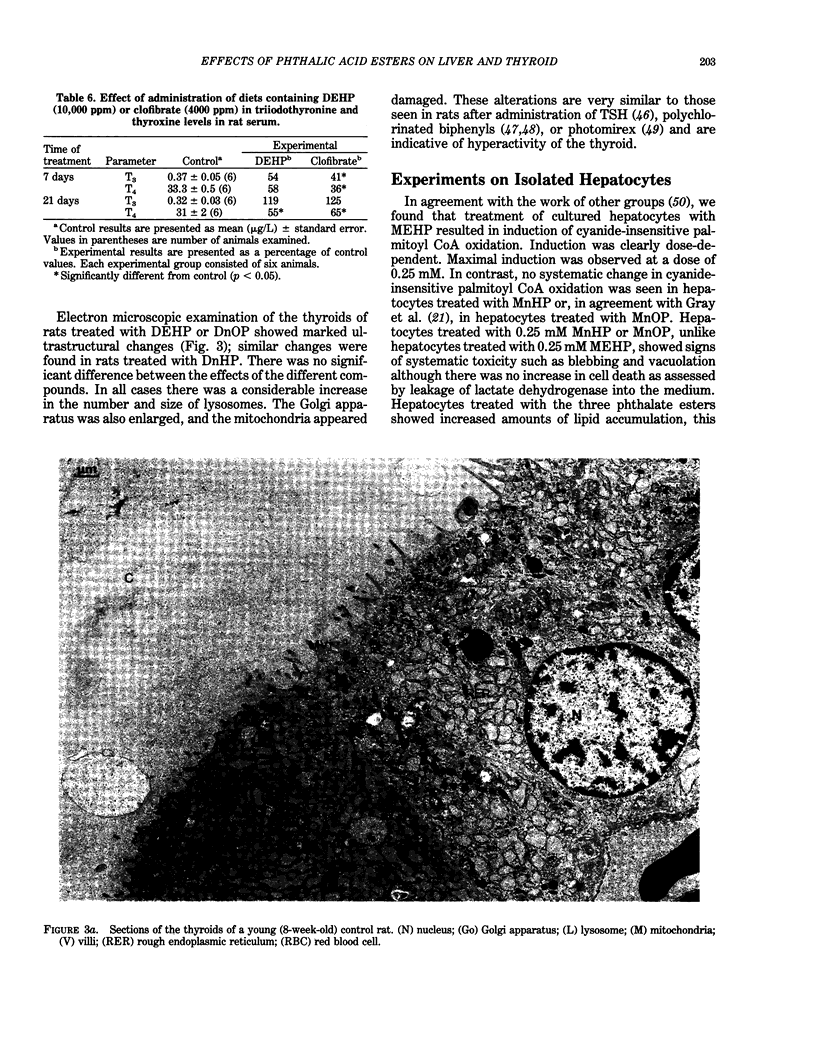
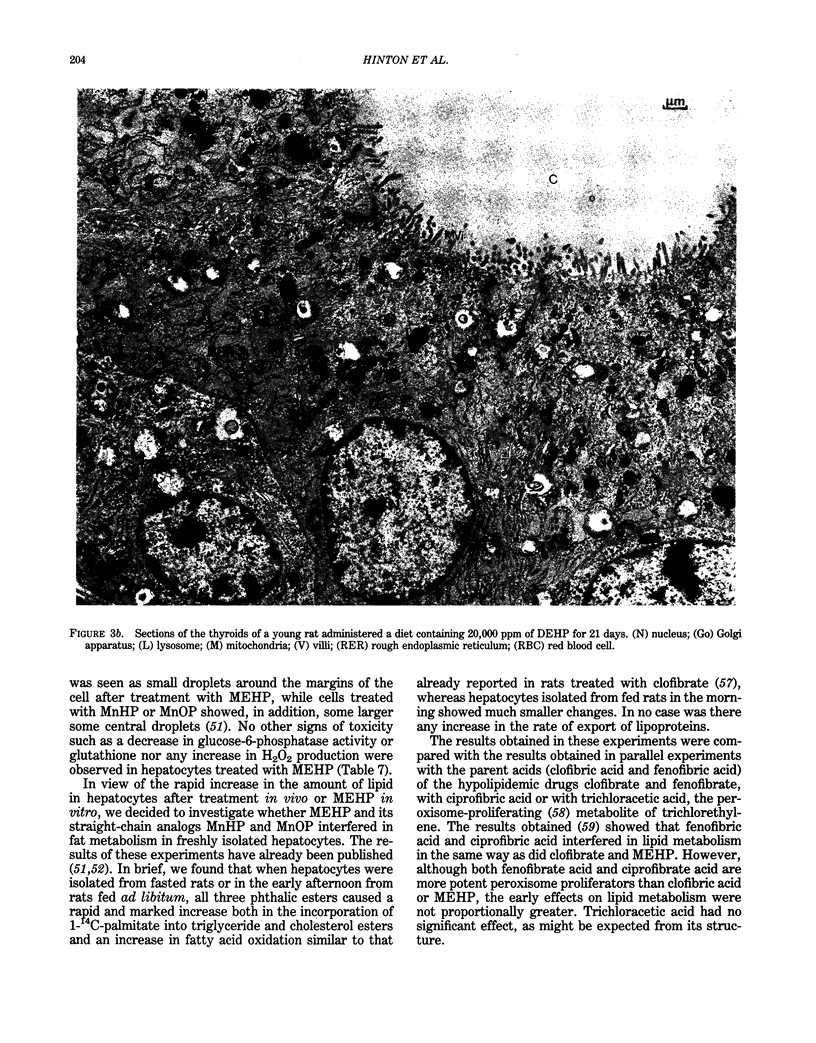
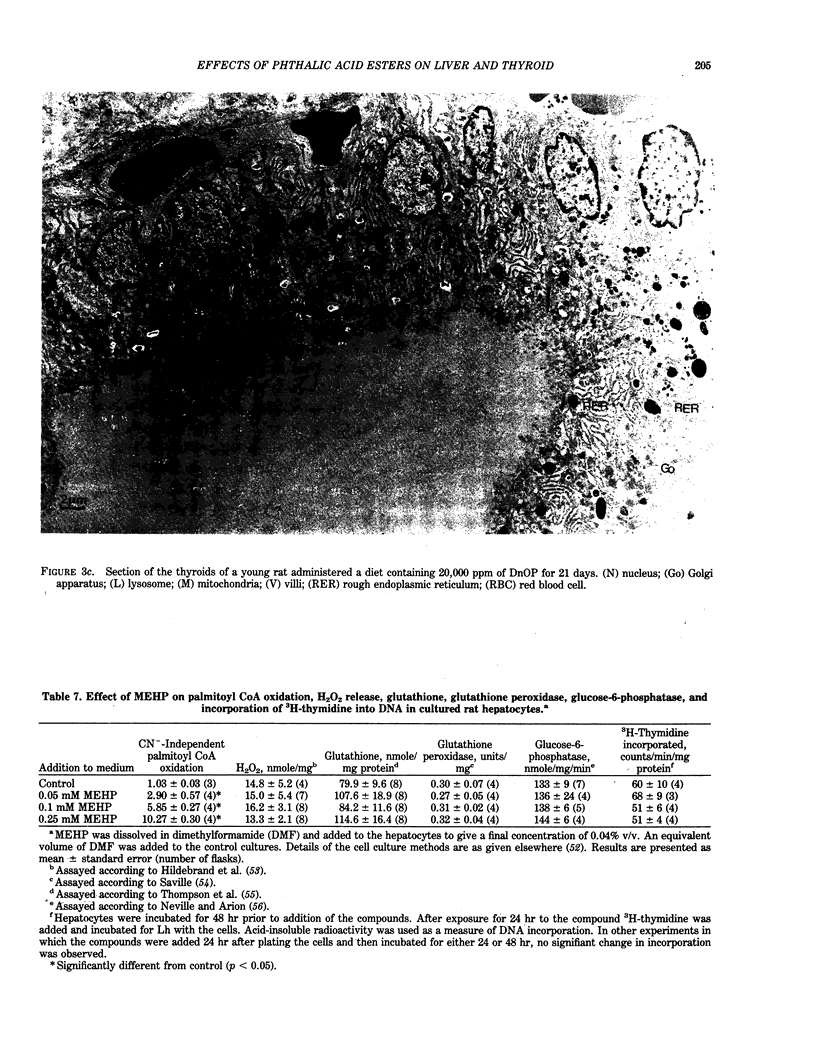
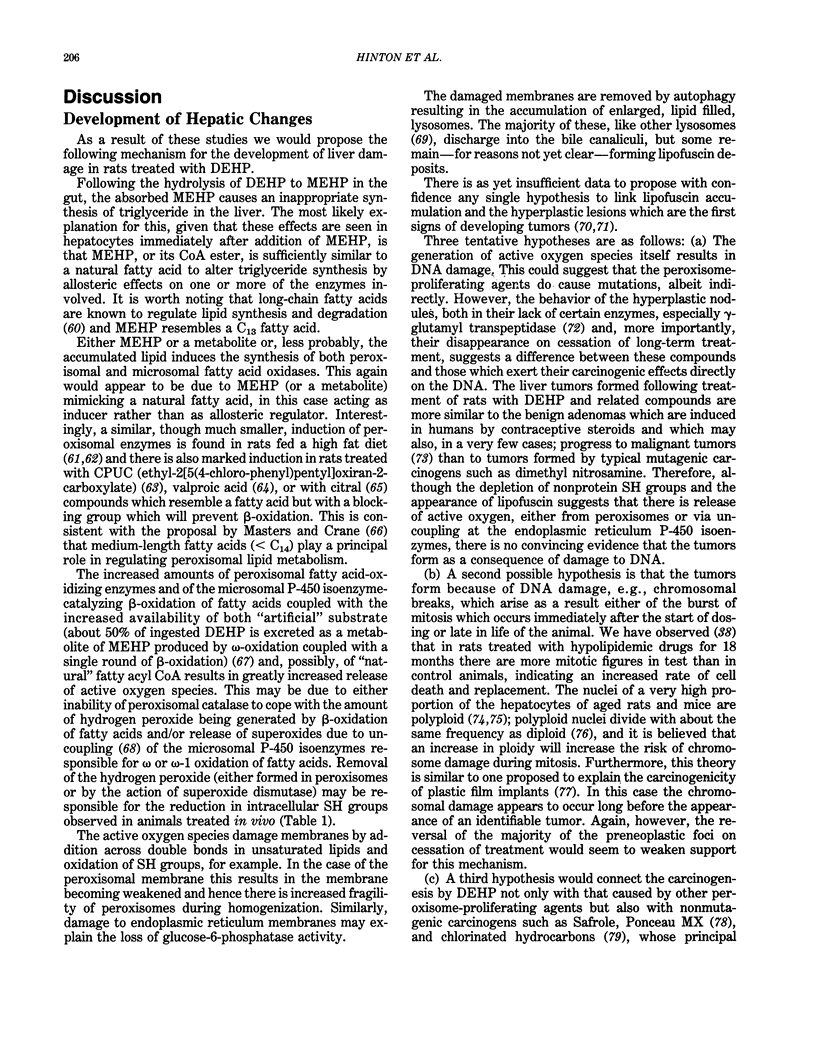
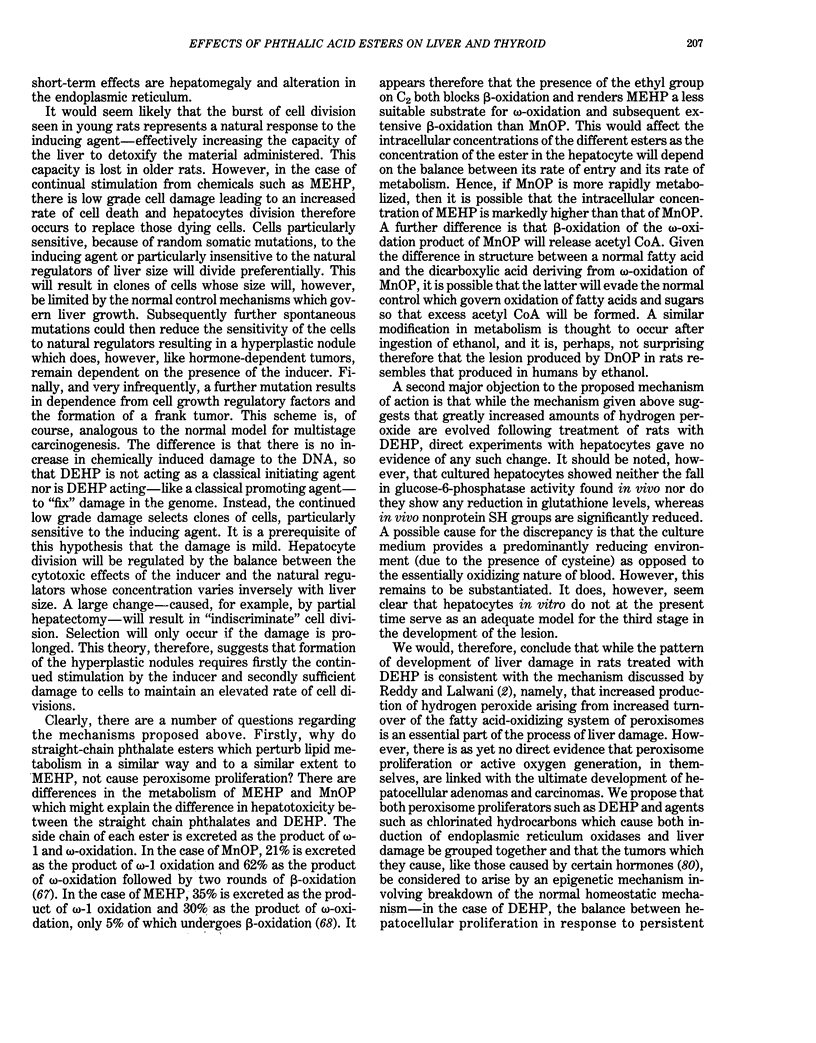
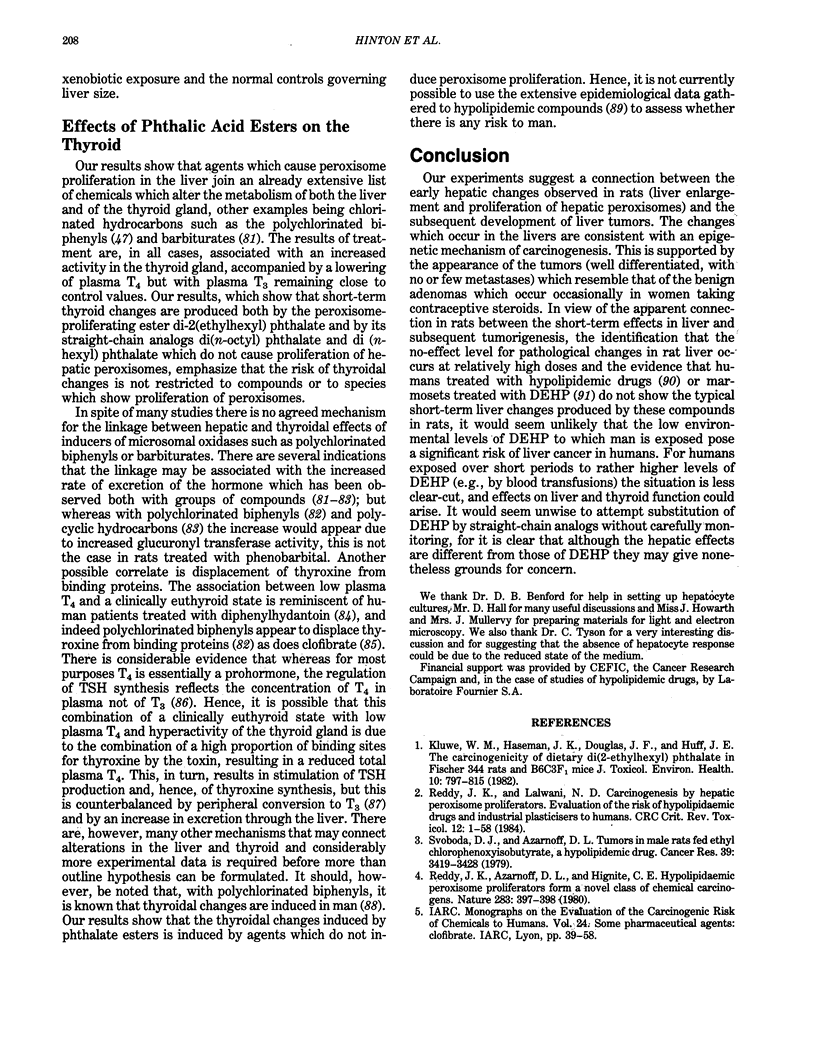
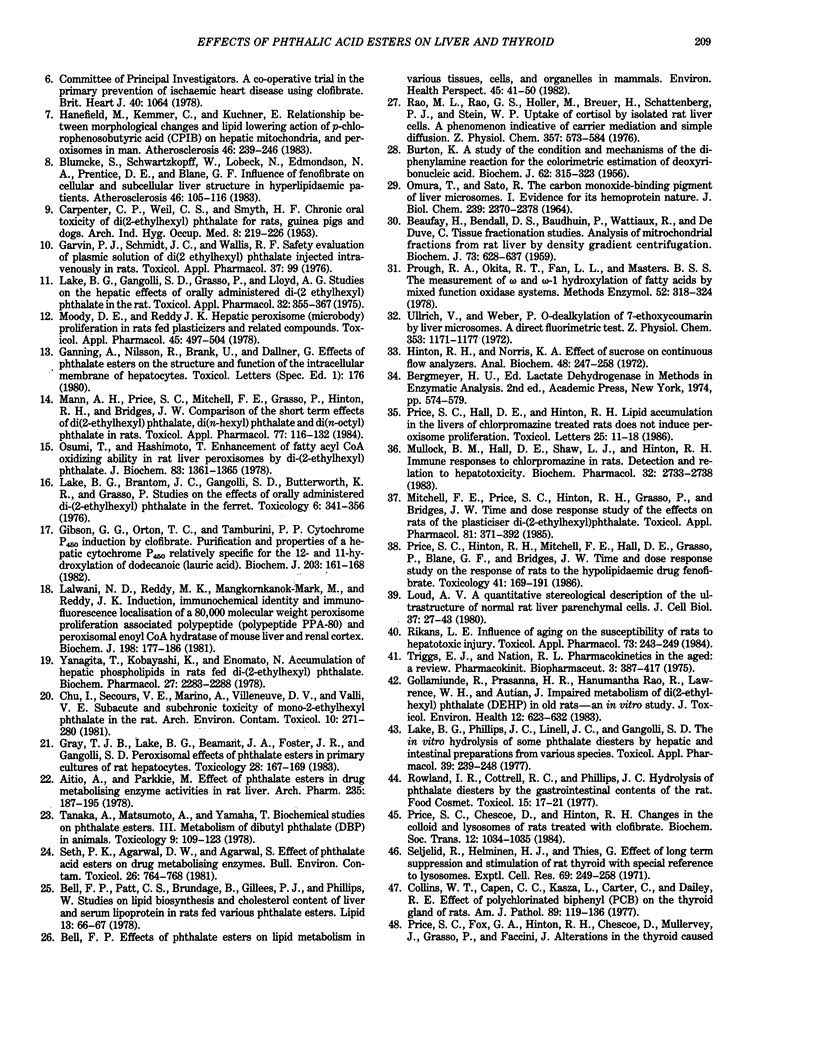
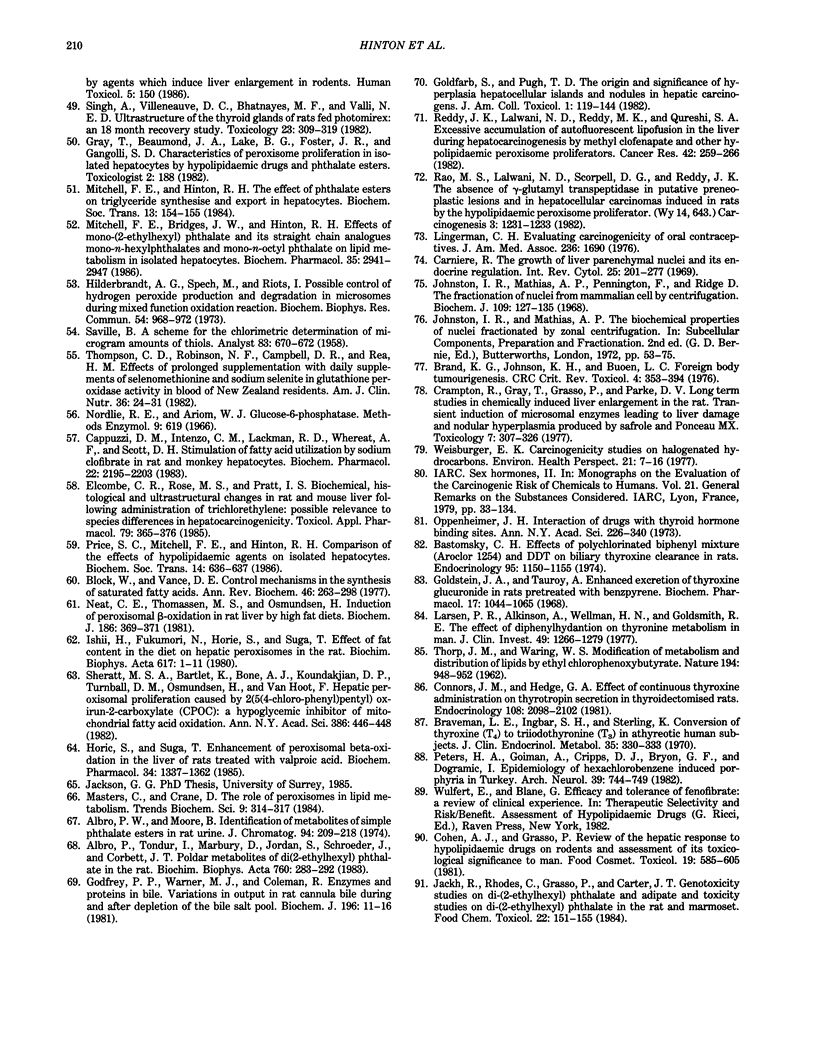
Images in this article
Selected References
These references are in PubMed. This may not be the complete list of references from this article.
- Aitio A., Parkki M. Effect of phthalate esters on drug metabolizing enzyme activities in rat liver. Arch Int Pharmacodyn Ther. 1978 Oct;235(2):187–195. [PubMed] [Google Scholar]
- Albro P. W., Moore B. Identification of the metabolites of simple phthalate diesters in rat urine. J Chromatogr. 1974 Jul 17;94(0):209–218. doi: 10.1016/s0021-9673(01)92368-4. [DOI] [PubMed] [Google Scholar]
- Albro P. W., Tondeur I., Marbury D., Jordan S., Schroeder J., Corbett J. T. Polar metabolites of di-(2-ethylhexyl)phthalate in the rat. Biochim Biophys Acta. 1983 Oct 18;760(2):283–292. doi: 10.1016/0304-4165(83)90175-7. [DOI] [PubMed] [Google Scholar]
- BEAUFAY H., BENDALL D. S., BAUDHUIN P., DE DUVE C. Tissue fractionation studies. 12. Intracellular distribution of some dehydrogenases, alkaline deoxyribonuclease and iron in rat-liver tissue. Biochem J. 1959 Dec;73:623–628. doi: 10.1042/bj0730623. [DOI] [PMC free article] [PubMed] [Google Scholar]
- BEAUFAY H., BENDALL D. S., BAUDHUN P., WATTIAUX R., DE DUVE C. Tissue fractionation studies. 13. Analysis of mitochondrial fractions from rat liver by density-gradient centrifuging. Biochem J. 1959 Dec;73:628–637. doi: 10.1042/bj0730628. [DOI] [PMC free article] [PubMed] [Google Scholar]
- BURTON K. A study of the conditions and mechanism of the diphenylamine reaction for the colorimetric estimation of deoxyribonucleic acid. Biochem J. 1956 Feb;62(2):315–323. doi: 10.1042/bj0620315. [DOI] [PMC free article] [PubMed] [Google Scholar]
- Bastomsky C. H. Effects of a polychlorinated biphenyl mixture (aroclor 1254) and DDT on biliary thyroxine excretion in rats. Endocrinology. 1974 Oct;95(4):1150–1155. doi: 10.1210/endo-95-4-1150. [DOI] [PubMed] [Google Scholar]
- Bell F. P. Effects of phthalate esters on lipid metabolism in various tissues, cells and organelles in mammals. Environ Health Perspect. 1982 Nov;45:41–50. doi: 10.1289/ehp.824541. [DOI] [PMC free article] [PubMed] [Google Scholar]
- Bloch K., Vance D. Control mechanisms in the synthesis of saturated fatty acids. Annu Rev Biochem. 1977;46:263–298. doi: 10.1146/annurev.bi.46.070177.001403. [DOI] [PubMed] [Google Scholar]
- Blümcke S., Schwartzkopff W., Lobeck H., Edmondson N. A., Prentice D. E., Blane G. F. Influence of fenofibrate on cellular and subcellular liver structure in hyperlipidemic patients. Atherosclerosis. 1983 Jan;46(1):105–116. doi: 10.1016/0021-9150(83)90169-7. [DOI] [PubMed] [Google Scholar]
- Brand K. G., Johnson K. H., Buoen L. C. Foreign body tumorigenesis. CRC Crit Rev Toxicol. 1976 Oct;4(4):353–394. doi: 10.1080/10408447609164018. [DOI] [PubMed] [Google Scholar]
- CARPENTER C. P., WEIL C. S., SMYTH H. F., Jr Chronic oral toxicity of di-(2-ethylhexyl) phthalate of rats, guinea pigs, and dogs. AMA Arch Ind Hyg Occup Med. 1953 Sep;8(3):219–226. [PubMed] [Google Scholar]
- Carriere R. The growth of liver parenchymal nuclei and its endocrine regulation. Int Rev Cytol. 1969;25:201–277. doi: 10.1016/s0074-7696(08)60204-1. [DOI] [PubMed] [Google Scholar]
- Chu I., Secours V. E., Marino I. A., Villeneuve D. C., Valli V. E. Sub-acute and sub-chronic toxicity of mono-2-ethylhexyl phthalate in the rat. Arch Environ Contam Toxicol. 1981;10(3):271–280. doi: 10.1007/BF01055628. [DOI] [PubMed] [Google Scholar]
- Cohen A. J., Grasso P. Review of the hepatic response to hypolipidaemic drugs in rodents and assessment of its toxicological significance to man. Food Cosmet Toxicol. 1981 Oct;19(5):585–605. doi: 10.1016/0015-6264(81)90509-5. [DOI] [PubMed] [Google Scholar]
- Collins W. T., Jr, Capen C. C., Kasza L., Carter C., Dailey R. E. Effect of polychlorinated biphenyl (PCB) on the thyroid gland of rats. Ultrastructural and biochemical investigations. Am J Pathol. 1977 Oct;89(1):119–136. [PMC free article] [PubMed] [Google Scholar]
- Connors J. M., Hedge G. A. Effect of continuous thyroxine administration on thyrotropin secretion in thyroidectomized rats. Endocrinology. 1981 Jun;108(6):2098–2102. doi: 10.1210/endo-108-6-2098. [DOI] [PubMed] [Google Scholar]
- Crampton R. F., Gray T. J., Grasso P., Parke D. V. Long-term studies on chemically induced liver enlargement in the rat. II. Transient induction of microsomal enzymes leading to liver damage and nodular hyperplasia produced by safrole and Ponceau MX. Toxicology. 1977 Jun;7(3):307–326. doi: 10.1016/0300-483x(77)90050-6. [DOI] [PubMed] [Google Scholar]
- Elcombe C. R., Rose M. S., Pratt I. S. Biochemical, histological, and ultrastructural changes in rat and mouse liver following the administration of trichloroethylene: possible relevance to species differences in hepatocarcinogenicity. Toxicol Appl Pharmacol. 1985 Jul;79(3):365–376. doi: 10.1016/0041-008x(85)90135-8. [DOI] [PubMed] [Google Scholar]
- Gibson G. G., Orton T. C., Tamburini P. P. Cytochrome P-450 induction by clofibrate. Purification and properties of a hepatic cytochrome P-450 relatively specific for the 12- and 11-hydroxylation of dodecanoic acid (lauric acid). Biochem J. 1982 Apr 1;203(1):161–168. doi: 10.1042/bj2030161. [DOI] [PMC free article] [PubMed] [Google Scholar]
- Godfrey P. P., Warner M. J., Coleman R. Enzymes and proteins in bile. Variations in output in rat cannula bile during and after depletion of the bile-salt pool. Biochem J. 1981 Apr 15;196(1):11–16. doi: 10.1042/bj1960011. [DOI] [PMC free article] [PubMed] [Google Scholar]
- Goldstein J. A., Taurog A. Enhanced biliary excretion of thyroxine glucuronide in rats pretreated with benzpyrene. Biochem Pharmacol. 1968 Jun;17(6):1049–1065. doi: 10.1016/0006-2952(68)90363-8. [DOI] [PubMed] [Google Scholar]
- Gollamudi R., Prasanna H. R., Rao R. H., Lawrence W. H., Autian J. Impaired metabolism of di(2-ethylhexyl) phthalate (DEHP) in old rats--an in vitro study. J Toxicol Environ Health. 1983 Oct-Dec;12(4-6):623–632. doi: 10.1080/15287398309530454. [DOI] [PubMed] [Google Scholar]
- Gray T. J., Lake B. G., Beamand J. A., Foster J. R., Gangolli S. D. Peroxisomal effects of phthalate esters in primary cultures of rat hepatocytes. Toxicology. 1983 Sep;28(1-2):167–179. doi: 10.1016/0300-483x(83)90115-4. [DOI] [PubMed] [Google Scholar]
- Hanefeld M., Kemmer C., Kadner E. Relationship between morphological changes and lipid-lowering action of p-chlorphenoxyisobutyric acid (CPIB) on hepatic mitochondria and peroxisomes in man. Atherosclerosis. 1983 Feb;46(2):239–246. doi: 10.1016/0021-9150(83)90115-6. [DOI] [PubMed] [Google Scholar]
- Hildebrandt A. G., Speck M., Roots I. Possible control of hydrogen peroxide production and degradation in microsomes during mixed function oxidation reaction. Biochem Biophys Res Commun. 1973 Oct 1;54(3):968–975. doi: 10.1016/0006-291x(73)90789-4. [DOI] [PubMed] [Google Scholar]
- Hinton R. H., Norris K. A. Effect of sucrose on continuous-flow analyzers. Anal Biochem. 1972 Jul;48(1):247–258. doi: 10.1016/0003-2697(72)90187-x. [DOI] [PubMed] [Google Scholar]
- Horie S., Suga T. Enhancement of peroxisomal beta-oxidation in the liver of rats and mice treated with valproic acid. Biochem Pharmacol. 1985 May 1;34(9):1357–1362. doi: 10.1016/0006-2952(85)90670-7. [DOI] [PubMed] [Google Scholar]
- Ishii H., Fukumori N., Horie S., Suga T. Effects of fat content in the diet on hepatic peroxisomes of the rat. Biochim Biophys Acta. 1980 Jan 18;617(1):1–11. doi: 10.1016/0005-2760(80)90218-0. [DOI] [PubMed] [Google Scholar]
- Johnston I. R., Mathias A. P., Pennington F., Ridge D. The fractionation of nuclei from mammalian cells by zonal centrifugation. Biochem J. 1968 Aug;109(1):127–135. doi: 10.1042/bj1090127. [DOI] [PMC free article] [PubMed] [Google Scholar]
- Jäckh R., Rhodes C., Grasso P., Carter J. T. Genotoxicity studies on di-(2-ethylhexyl) phthalate and adipate and toxicity studies on di-(2-ethylhexyl) phthalate in the rat and marmoset. Food Chem Toxicol. 1984 Feb;22(2):151–155. doi: 10.1016/0278-6915(84)90096-6. [DOI] [PubMed] [Google Scholar]
- Kluwe W. M., Haseman J. K., Douglas J. F., Huff J. E. The carcinogenicity of dietary di(2-ethylhexyl) phthalate (DEHP) in Fischer 344 rats and B6C3F1 mice. J Toxicol Environ Health. 1982 Oct-Nov;10(4-5):797–815. doi: 10.1080/15287398209530296. [DOI] [PubMed] [Google Scholar]
- Lake B. G., Brantom P. G., Gangolli S. D., Butterworth K. R., Grasso P. Studies on the effects of orally administered Di-(2-ethylhexyl) phthalate in the ferret. Toxicology. 1976 Nov-Dec;6(3):341–356. doi: 10.1016/0300-483x(76)90038-x. [DOI] [PubMed] [Google Scholar]
- Lake B. G., Gangolli S. D., Grasso P., Lloyd A. G. Studies on the hepatic effects of orally administered di-)2-ethylhexyl) phthalate in the rat. Toxicol Appl Pharmacol. 1975 May;32(2):355–367. doi: 10.1016/0041-008x(75)90226-4. [DOI] [PubMed] [Google Scholar]
- Lake B. G., Phillips J. C., Linnell J. C., Gangolli S. D. The in vitro hydrolysis of some phthalate diesters by hepatic and intestinal preparations from various species. Toxicol Appl Pharmacol. 1977 Feb;39(2):239–248. doi: 10.1016/0041-008x(77)90157-0. [DOI] [PubMed] [Google Scholar]
- Lalwani N. D., Reddy M. K., Mangkornkanok-Mark M., Reddy J. K. Induction, immunochemical identity and immunofluorescence localization of an 80 000-molecular-weight peroxisome-proliferation-associated polypeptide (polypeptide PPA-80) and peroxisomal enoyl-CoA hydratase of mouse liver and renal cortex. Biochem J. 1981 Jul 15;198(1):177–186. doi: 10.1042/bj1980177. [DOI] [PMC free article] [PubMed] [Google Scholar]
- Larsen P. R., Atkinson A. J., Jr, Wellman H. N., Goldsmith R. E. The effect of diphenylhydantoin on thyroxine metabolism in man. J Clin Invest. 1970 Jun;49(6):1266–1279. doi: 10.1172/JCI106339. [DOI] [PMC free article] [PubMed] [Google Scholar]
- Loud A. V. A quantitative stereological description of the ultrastructure of normal rat liver parenchymal cells. J Cell Biol. 1968 Apr;37(1):27–46. doi: 10.1083/jcb.37.1.27. [DOI] [PMC free article] [PubMed] [Google Scholar]
- Mann A. H., Price S. C., Mitchell F. E., Grasso P., Hinton R. H., Bridges J. W. Comparison of the short-term effects of di(2-ethylhexyl) phthalate, di(n-hexyl) phthalate, and di(n-octyl) phthalate in rats. Toxicol Appl Pharmacol. 1985 Jan;77(1):116–132. doi: 10.1016/0041-008x(85)90273-x. [DOI] [PubMed] [Google Scholar]
- Mitchell F. E., Bridges J. W., Hinton R. H. Effects of mono (2-ethylhexyl) phthalate and its straight chain analogues mono-n-hexylphthalate and mono-n-octyl phthalate on lipid metabolism in isolated hepatocytes. Biochem Pharmacol. 1986 Sep 1;35(17):2941–2947. doi: 10.1016/0006-2952(86)90490-9. [DOI] [PubMed] [Google Scholar]
- Mitchell F. E., Price S. C., Hinton R. H., Grasso P., Bridges J. W. Time and dose-response study of the effects on rats of the plasticizer di(2-ethylhexyl) phthalate. Toxicol Appl Pharmacol. 1985 Dec;81(3 Pt 1):371–392. doi: 10.1016/0041-008x(85)90409-0. [DOI] [PubMed] [Google Scholar]
- Moody D. E., Reddy J. K. Hepatic peroxisome (microbody) proliferation in rats fed plasticizers and related compounds. Toxicol Appl Pharmacol. 1978 Aug;45(2):497–504. doi: 10.1016/0041-008x(78)90111-4. [DOI] [PubMed] [Google Scholar]
- Mullock B. M., Hall D. E., Shaw L. J., Hinton R. H. Immune responses to chlorpromazine in rats. Detection and relation to hepatotoxicity. Biochem Pharmacol. 1983 Sep 15;32(18):2733–2738. doi: 10.1016/0006-2952(83)90084-9. [DOI] [PubMed] [Google Scholar]
- Neat C. E., Thomassen M. S., Osmundsen H. Induction of peroxisomal beta-oxidation in rat liver by high-fat diets. Biochem J. 1980 Jan 15;186(1):369–371. doi: 10.1042/bj1860369. [DOI] [PMC free article] [PubMed] [Google Scholar]
- OMURA T., SATO R. THE CARBON MONOXIDE-BINDING PIGMENT OF LIVER MICROSOMES. I. EVIDENCE FOR ITS HEMOPROTEIN NATURE. J Biol Chem. 1964 Jul;239:2370–2378. [PubMed] [Google Scholar]
- Oppenheimer J. H. Interaction of drugs with thyroid hormone binding sites. Ann N Y Acad Sci. 1973 Nov 26;226:333–340. doi: 10.1111/j.1749-6632.1973.tb20494.x. [DOI] [PubMed] [Google Scholar]
- Osumi T., Hashimoto T. Enhancement of fatty acyl-CoA oxidizing activity in rat liver peroxisomes by di-(i-ethylhexyl)phthalate. J Biochem. 1978 May;83(5):1361–1365. doi: 10.1093/oxfordjournals.jbchem.a132044. [DOI] [PubMed] [Google Scholar]
- Peters H. A., Gocmen A., Cripps D. J., Bryan G. T., Dogramaci I. Epidemiology of hexachlorobenzene-induced porphyria in Turkey: clinical and laboratory follow-up after 25 years. Arch Neurol. 1982 Dec;39(12):744–749. doi: 10.1001/archneur.1982.00510240006002. [DOI] [PubMed] [Google Scholar]
- Price S. C., Hinton R. H., Mitchell F. E., Hall D. E., Grasso P., Blane G. F., Bridges J. W. Time and dose study on the response of rats to the hypolipidaemic drug fenofibrate. Toxicology. 1986 Oct;41(2):169–191. doi: 10.1016/0300-483x(86)90198-8. [DOI] [PubMed] [Google Scholar]
- Prough R. A., Okita R. T., Fan L. L., Masters B. S. The measurement of omega- and omega-1 hydroxylation of fatty acids by mixed-function oxidase systems. Methods Enzymol. 1978;52:318–324. doi: 10.1016/s0076-6879(78)52034-x. [DOI] [PubMed] [Google Scholar]
- Rao M. L., Rao G. S., Höller M., Breuer H., Schattenberg P. J., Stein W. D. Uptake of cortisol by isolated rat liver cells. A phenomenon indicative of carrier-mediation and simple diffusion. Hoppe Seylers Z Physiol Chem. 1976 Apr;357(4):573–584. doi: 10.1515/bchm2.1976.357.1.573. [DOI] [PubMed] [Google Scholar]
- Rao M. S., Lalwani N. D., Scarpelli D. G., Reddy J. K. The absence of gamma-glutamyl transpeptidase activity in putative preneoplastic lesions and in hepatocellular carcinomas induced in rats by the hypolipidemic peroxisome proliferator Wy-14,643. Carcinogenesis. 1982;3(10):1231–1233. doi: 10.1093/carcin/3.10.1231. [DOI] [PubMed] [Google Scholar]
- Reddy J. K., Azarnoff D. L., Hignite C. E. Hypolipidaemic hepatic peroxisome proliferators form a novel class of chemical carcinogens. Nature. 1980 Jan 24;283(5745):397–398. doi: 10.1038/283397a0. [DOI] [PubMed] [Google Scholar]
- Reddy J. K., Lalwai N. D. Carcinogenesis by hepatic peroxisome proliferators: evaluation of the risk of hypolipidemic drugs and industrial plasticizers to humans. Crit Rev Toxicol. 1983;12(1):1–58. doi: 10.3109/10408448309029317. [DOI] [PubMed] [Google Scholar]
- Reddy J. K., Lalwani N. D., Reddy M. K., Qureshi S. A. Excessive accumulation of autofluorescent lipofuscin in the liver during hepatocarcinogenesis by methyl clofenapate and other hypolipidemic peroxisome proliferators. Cancer Res. 1982 Jan;42(1):259–266. [PubMed] [Google Scholar]
- Rikans L. E. Influence of aging on the susceptibility of rats to hepatotoxic injury. Toxicol Appl Pharmacol. 1984 Apr;73(2):243–249. doi: 10.1016/0041-008x(84)90329-6. [DOI] [PubMed] [Google Scholar]
- Rowland I. R., Cottrell R. C., Phillips J. C. Hydrolysis of phthalate esters by the gastro-intestinal contents of the rat. Food Cosmet Toxicol. 1977 Feb;15(1):17–21. doi: 10.1016/s0015-6264(77)80257-5. [DOI] [PubMed] [Google Scholar]
- Seljelid R., Helminen H. J., Thies G. Effect of long-term suppression and stimulation of rat thyroid with special reference to lysosomes. Exp Cell Res. 1971 Dec;69(2):249–258. doi: 10.1016/0014-4827(71)90221-7. [DOI] [PubMed] [Google Scholar]
- Seth P. K., Agarwal D. K., Agarwal S. Effect of phthalic acid esters on drug metabolizing enzymes. Bull Environ Contam Toxicol. 1981 Jun;26(6):764–768. doi: 10.1007/BF01622168. [DOI] [PubMed] [Google Scholar]
- Singh A., Villeneuve D. C., Bhatnagar M. K., Valli V. E. Ultrastructure of the thyroid glands of rats fed photomirex: an 18-month recovery study. Toxicology. 1982;23(4):309–319. doi: 10.1016/0300-483x(82)90069-5. [DOI] [PubMed] [Google Scholar]
- Svoboda D. J., Azarnoff D. L. Tumors in male rats fed ethyl chlorophenoxyisobutyrate, a hypolipidemic drug. Cancer Res. 1979 Sep;39(9):3419–3428. [PubMed] [Google Scholar]
- THORP J. M., WARING W. S. Modification of metabolism and distribution of lipids by ethyl chlorophenoxyisobutyrate. Nature. 1962 Jun 9;194:948–949. doi: 10.1038/194948a0. [DOI] [PubMed] [Google Scholar]
- Tanaka A., Matsumoto A., Yamaha T. Biochemical studies on phthalic esters. III. Metabolism of dibutyl phthalate (DBP) in animals. Toxicology. 1978 Feb;9(1-2):109–123. doi: 10.1016/0300-483x(78)90036-7. [DOI] [PubMed] [Google Scholar]
- Thomson C. D., Robinson M. F., Campbell D. R., Rea H. M. Effect of prolonged supplementation with daily supplements of selenomethionine and sodium selenite on glutathione peroxidase activity in blood of New Zealand residents. Am J Clin Nutr. 1982 Jul;36(1):24–31. doi: 10.1093/ajcn/36.1.24. [DOI] [PubMed] [Google Scholar]
- Ullrich V., Weber P. The O-dealkylation of 7-ethoxycoumarin by liver microsomes. A direct fluorometric test. Hoppe Seylers Z Physiol Chem. 1972 Jul;353(7):1171–1177. doi: 10.1515/bchm2.1972.353.2.1171. [DOI] [PubMed] [Google Scholar]
- Weisburger E. K. Carcinogenicity studies on halogenated hydrocarbons. Environ Health Perspect. 1977 Dec;21:7–16. doi: 10.1289/ehp.77217. [DOI] [PMC free article] [PubMed] [Google Scholar]
- Yanagita T., Kobayashi K., Enomoto N. Accumulation of hepatic phospholipids in rats fed di-2-ethylhexyl phthalate. Biochem Pharmacol. 1978;27(19):2283–2288. doi: 10.1016/0006-2952(78)90132-6. [DOI] [PubMed] [Google Scholar]







